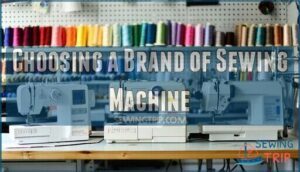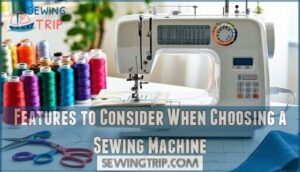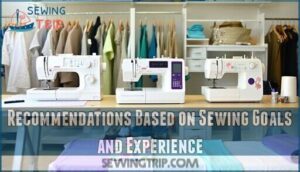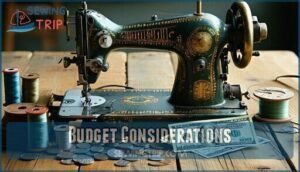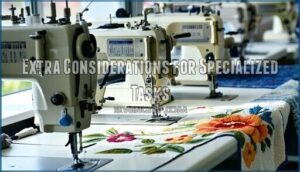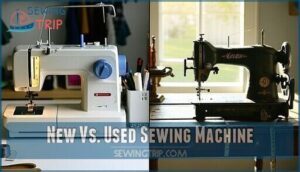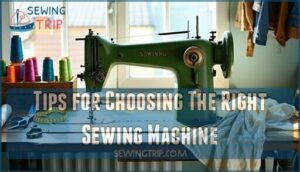This site is supported by our readers. We may earn a commission, at no cost to you, if you purchase through links.
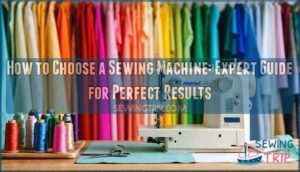 When you’re figuring out how to choose a sewing machine, start with your skill level and what you’ll actually sew.
When you’re figuring out how to choose a sewing machine, start with your skill level and what you’ll actually sew.
Beginners should focus on simple, reliable machines with basic stitches, while experienced sewers can handle computerized models with more features.
Consider your budget—you don’t need the fanciest machine to create beautiful projects.
Check the stitch quality, threading system, and available accessories.
Think about fabric types you’ll use; heavy materials need stronger motors.
Test the machine’s feel and noise level if possible.
A good machine should grow with your skills, not overwhelm you from day one.
The right features can make all the difference in your sewing journey.
Table Of Contents
- Key Takeaways
- Top 3 Sewing Machines for Beginners and Experienced Sewers
- Types of Sewing Machines
- How Sewing Machines Work
- Choosing a Brand of Sewing Machine
- Features to Consider When Choosing a Sewing Machine
- Recommendations Based on Sewing Goals and Experience
- Budget Considerations
- Extra Considerations for Specialized Tasks
- New Vs. Used Sewing Machine
- Tips for Choosing The Right Sewing Machine
- Frequently Asked Questions (FAQs)
- Conclusion
Key Takeaways
- Match your skill level to machine complexity – You’ll want a simple, reliable mechanical machine if you’re starting out, but can handle computerized models with advanced features once you’ve developed experience.
- Set a realistic budget that aligns with your needs – You should expect to spend $150-300 for a quality beginner machine, but don’t overspend on features you won’t actually use.
- Prioritize essential features over flashy extras – You’ll need basic stitches, an automatic buttonhole function, and good stitch quality more than dozens of decorative stitches you’ll rarely touch.
- Test machines hands-on before buying – You can’t judge a machine’s feel, noise level, and ease of use from online specs alone, so visit stores to try different models with actual fabric.
Top 3 Sewing Machines for Beginners and Experienced Sewers
You’ll find three standout sewing machines that work well for both beginners learning basic stitches and experienced sewers tackling complex projects.
These machines offer the right balance of user-friendly features and advanced capabilities, so you won’t outgrow your investment as your skills improve, with a good balance of advanced capabilities.
Bernette Sew Go Swiss Design Sewing Machine
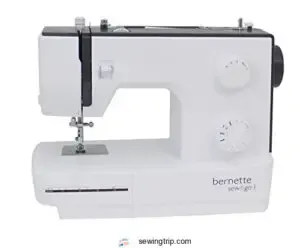
The Bernette Sew Go delivers Swiss Design reliability in a compact 15-pound package that won’t dominate your workspace.
Compact Swiss engineering that transforms any corner into your personal sewing studio.
Its Bernette Features include straightforward stitch selection and smooth threading that makes setup simple for newcomers.
This sewing machine excels at basic projects like hemming and crafting, though Project Limitations mean complex embroidery isn’t possible.
The excellent Portability Factors let you easily move it between rooms or take it to classes.
For Beginner Suitability, you can’t beat its quiet operation and consistent stitching quality that builds confidence with every seam.
Juki Computerized Sewing Machine HZL LB5020
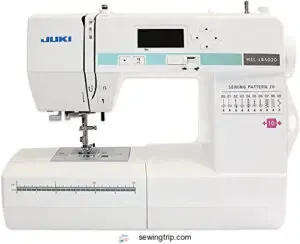
You’ll find the Juki HZL-LB5020 strikes the perfect balance between simplicity and performance in this computerized sewing machine buying guide.
The HZL LB5020 Features include 20 essential stitches that cover everything from basic straight seams to decorative options, making it ideal for both beginners and experienced sewers.
The Juki LB5020 Price reflects excellent value when you consider its aluminum construction and seven-point feed dog system.
This LB5020 Performance Review consistently shows smooth fabric handling without bunching, even through multiple layers.
You’ll appreciate the drop-in bobbin system and automatic needle threader that eliminate threading frustrations.
The variable speed control lets you tackle heavy fabrics at your own pace, while the one-step buttonhole feature delivers professional results every time.
The free arm design and included presser feet handle appliqué, zigzag stitching, and blind hems with ease.
When considering Juki LB5020 Alternatives, remember this model’s reputation for reliability.
For LB5020 Maintenance Tips, regular cleaning and oiling keep this workhorse running smoothly for years.
Janome Sewing Machine Bundle
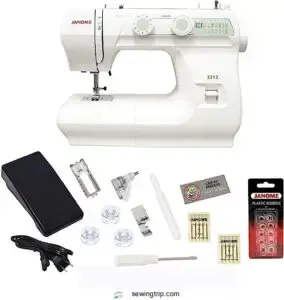
When you’re shopping for your first sewing machine, this Janome bundle delivers excellent value with everything you need to start creating.
The mechanical design keeps things simple – just turn dials to select from 12 built-in stitches and adjust settings without complicated computerized menus.
Bundle inclusions typically feature essential presser feet, bobbins, and Janome accessories that would cost extra elsewhere.
This sturdy white metal machine handles basic projects beautifully, from hemming pants to crafting quilts.
The free arm tackles sleeves easily, while dropped feed dogs enable free-motion techniques.
Though it lacks automatic threading, this reliable workhorse offers dependable performance that makes it a smart choice among sewing machine brands for beginners seeking quality without breaking the bank.
Types of Sewing Machines
When you’re exploring the sphere of sewing machine types, understanding your options helps you make the right choice. Each category serves different needs and skill levels.
Here are the main sewing machine types to examine:
- Mechanical vs. Computerized – Mechanical machines use knobs and levers, while computerized models offer digital controls and preset stitches
- Heavy-Duty Capabilities – These powerhouses handle thick fabrics like denim and leather with ease
- Specialty Machine Uses – Sergers, embroidery machines, and quilting models serve specific purposes
- Portability Considerations – Lightweight machines travel well, while full-size models offer more features
- Vintage Machine Value – Manual machines provide complete control without electricity
Mechanical machines are budget-friendly and durable, perfect for basic tasks. Computerized sewing machines automate functions like stitch selection and tension control. Heavy duty sewing machines power through tough materials. Your beginner sewing machine choice depends on your projects, budget, and experience level.
How Sewing Machines Work
Understanding your sewing machine’s inner workings transforms you from a button-pusher into a confident crafter. At its heart, the Motor Operation powers everything, driving the needle up and down while coordinating multiple sewing machine parts.
Master your machine’s mechanics and transform from hesitant beginner into confident creator with every perfect stitch.
The magic happens through precise Stitch Formation. Your needle pierces fabric while the bobbin thread loops around it underneath, creating interlocked stitches. The Bobbin Winding system guarantees smooth thread delivery from below.
Meanwhile, the Feed Mechanism uses feed dogs – those metal teeth beneath your fabric – to grab and move material forward at consistent intervals. The Tension System balances thread tightness between top and bottom threads, preventing puckering or loose stitches.
Key sewing machine features work together seamlessly:
- Needle bar drives the needle through precise up-down motions
- Bobbin case holds the lower thread and rotates smoothly
- Presser foot applies gentle pressure to keep fabric flat
- Feed dogs grip and advance fabric with each stitch cycle
- Thread guides direct thread along the correct path
- Tension discs squeeze thread to control tightness perfectly.
Mastering these fundamentals helps you troubleshoot problems and achieve professional results.
Choosing a Brand of Sewing Machine
Brand reputation separates reliable workhorses from frustrating disappointments. You’ll want manufacturers who’ve earned trust through consistent performance and responsive customer service.
Here are five key factors to evaluate when comparing sewing machine brands:
- Brand reputation – Singer, Brother, and Janome lead with decades of proven reliability
- Warranty coverage – Look for extensive protection lasting 2-5 years minimum
- Parts availability – Verify replacement components remain accessible long-term
- User reviews – Real experiences reveal common issues and standout features
- Innovation history – Brands investing in R&D typically offer better long-term value
Brother delivers exceptional price-to-function ratios with lightweight designs. Janome excels in mechanical precision and quiet operation. Singer offers wide selection but quality varies by model.
For sewing machine recommendations, prioritize brands with strong local dealer networks providing hands-on support and service accessibility. A vital aspect is having an adjustable stitch length.
Features to Consider When Choosing a Sewing Machine
Once you’ve narrowed down your brand preferences, it’s time to examine the specific sewing machine features that’ll make or break your sewing experience.
The right machine features can transform your projects from frustrating struggles into smooth sailing.
Stitch Variety tops your sewing machine selection checklist. You’ll want basic straight and zigzag stitches, plus buttonhole options. More advanced sewers benefit from decorative and specialty stitches that add personality to their work.
Presser Feet determine what techniques you can master. Look for snap-on feet that swap easily – zipper feet, buttonhole feet, and hemming feet expand your capabilities substantially.
Key features that enhance control include:
- Free Arm for sewing sleeves and cuffs without wrestling fabric
- Needle Position adjustment for precise topstitching and zipper insertion
- Speed Control to match your comfort level and project complexity.
Before purchasing, consider your sewing frequency to assess your long-term needs. Consider your sewing machine buying guide complete when these features align with your creative goals.
Recommendations Based on Sewing Goals and Experience
Matching your sewing machine to your experience level saves time and frustration. Your sewing goals shape which features you’ll actually use versus what sounds impressive in the store.
| Experience Level | Recommended Features | Ideal Projects |
|---|---|---|
| Complete Beginner | Basic stitches, automatic threading, simple controls | Hemming, repairs, straight seams |
| Developing Skills | Multiple stitches, buttonhole function, adjustable settings | Garments, home décor, quilting basics |
| Advanced Sewer | Computerized controls, specialty stitches, embroidery capability | Complex garments, professional finishing |
| Professional/Expert | Industrial features, high-speed operation, commercial durability | Heavy fabrics, mass production, intricate work |
Consider your Long-Term Goals when selecting. A beginner sewing machine with room for Skill Progression prevents outgrowing your investment quickly. The Machine Learning Curve varies—some prefer starting simple, others want features they’ll eventually use. Many sewers start with a simple starter model.
Budget Considerations
Before diving into sewing machine shopping, you’ll need to establish a realistic budget that matches both your skill level and sewing ambitions.
Sewing machines range from $50 to $15,000, making budget expansion planning vital for long-term satisfaction.
Here are key affordability factors:
- Basic mechanical machines cost under $100, while computerized models exceed $1,000
- Long-term costs include maintenance, repairs, and accessory purchases over time
- Feature prioritization helps avoid overspending on unused functions you won’t need
- Financing options through retailers can spread payments for higher-quality machines
Start with a beginner sewing machine that delivers solid performance without breaking the bank.
Exploring options for a sewing machine budget may help you find suitable choices.
Consider your sewing machine budget carefully—cheaper isn’t always better if it leads to frustration.
Quality matters more than flashy features, especially when you’re learning the basics of successful stitching.
Extra Considerations for Specialized Tasks
When your sewing projects get ambitious, you’ll need a machine that can keep up with your creative vision.
Quilting features like extended workspace and specialized presser feet make maneuvering large projects manageable.
A quilting sewing machine with a walking foot prevents fabric layers from shifting during assembly.
For dressmaking needs, look for automatic buttonholes and blind hem capabilities that create professional finishes.
An embroidery sewing machine opens up decorative possibilities with built-in fonts and stabilizer compatibility.
Upholstery options require heavy-duty construction and adjustable stitch settings.
A sewing machine for thick fabrics, leather, or denim needs the power to penetrate multiple layers without breaking needles.
Specialty stitches like stretch and overlock accommodate different fabric types.
Fabric compatibility matters more than you’d think.
Your machine should handle everything from delicate silks to sturdy canvas.
Consider what you’ll sew most often, then choose features that support those specific techniques.
New Vs. Used Sewing Machine
When you’re ready to buy your first sewing machine, you’ll face a big decision: new or used? Both options have their perks, but your choice depends on your budget and comfort level with repairs.
| Factor | New Sewing Machine | Used Sewing Machine |
|---|---|---|
| Warranty Options | Full manufacturer coverage | Limited or no warranty |
| Repair Costs | Covered under warranty | Your responsibility |
| Machine Condition | Perfect, untested reliability | Varies, requires inspection |
New machines offer peace of mind with full warranty options and guaranteed machine condition. However, used sewing machines can stretch your budget further, letting you afford higher-end models.
Check the sewing machine price difference – you might snag a premium model for half the cost. Test stitch quality, inspect all moving parts, and verify feature availability before buying used. Remember, repair costs on entry-level machines often exceed replacement value.
Tips for Choosing The Right Sewing Machine
Finding the perfect sewing machine doesn’t have to feel like searching for a needle in a haystack. Your success depends on honest self-assessment and smart planning before you spend a dime.
Here are five essential tips for your sewing machine buying guide:
- Match your skill level – Don’t buy a computerized powerhouse if you’re just learning basic stitches. A sewing machine for beginners should focus on reliability over bells and whistles.
- Evaluate project complexity – Consider what you’ll actually make. Simple repairs need different sewing machine features than quilting or embroidery projects.
- Assess space considerations – Measure your workspace and storage area. Full-size machines offer more capabilities but require dedicated room.
- Prioritize fabric versatility – Choose machines that handle your preferred materials, from delicate silks to heavy denim.
- Focus on feature prioritization – Identify must-have versus nice-to-have functions based on your sewing machine needs. Consider also the adjustable stitch settings for different fabric types.
Frequently Asked Questions (FAQs)
Should you buy a mechanical or computerized sewing machine?
About 70% of sewers upgrade within two years.
Choose mechanical if you’re budget-conscious and want durability—they’re simpler to repair.
Pick computerized for precision, automated features, and decorative stitches, but expect higher costs.
How do I choose a sewing machine?
Consider your skill level, budget, and project types first.
Match machine features to your needs—basic stitches for beginners, heavy-duty for thick fabrics, computerized for precision.
Test before buying to confirm comfort.
How do I buy a sewing machine?
Many believe you need expensive machines for quality results, but that’s not true.
You’ll find great machines at fabric stores, online retailers, or sewing centers.
Compare prices, read reviews, and test models before purchasing, to ensure you get the best quality results and make an informed decision about your great machines.
Should you compare a sewing machine before buying one?
Absolutely compare sewing machines before buying.
Check features like stitch variety, buttonhole options, and included presser feet.
Test different models in-store when possible.
Read reviews and compare prices to find your perfect match, considering factors like stitch variety.
What should I know before buying a sewing machine?
Sarah bought her first machine without research and struggled with thick denim projects.
Before purchasing, you’ll need to determine your primary sewing projects, budget range, space constraints, and desired features like automatic threading or computerized controls.
How to choose a sewing machine for quilting?
Look for machines with large throat space, extension tables, and adjustable stitch length.
You’ll need good lighting, needle down features, and walking feet attachments.
Heavy-duty models handle multiple fabric layers better than standard machines, with heavy-duty features and adjustable stitch length being key considerations.
What to look for when choosing a sewing machine?
Over 80% of sewers abandon their first machine within two years due to poor choices.
You’ll want adjustable stitch length, reliable buttonhole features, good lighting, and needle threading assistance for successful projects.
What is the best sewing machine for home use?
For home use, you’ll want a reliable mechanical or computerized machine with basic stitches, automatic buttonhole, free arm, and good lighting.
Brother XM2701 or Singer Start offer excellent value for beginners.
How much should a beginner spend on a sewing machine?
You’ll want to budget $150-300 for your first machine.
This range gets you reliable mechanical models with essential features like adjustable stitches, buttonholes, and free arms without overwhelming complexity or unnecessary bells and whistles.
How do I know a good sewing machine?
A diamond in the rough reveals itself through solid construction and smooth operation.
Check the machine’s weight, test stitch quality on various fabrics, and verify consistent tension control for reliable performance.
Conclusion
Mastering how to choose a sewing machine isn’t rocket science, but it’ll transform your crafting experience forever.
You’ve got the knowledge now—from understanding different machine types to evaluating essential features and budget considerations.
Remember, the perfect machine matches your current skills while leaving room for growth.
Don’t overthink it; trust your research and hands-on testing.
Whether you’re hemming curtains or creating couture masterpieces, the right machine will become your most trusted creative partner for years ahead.

